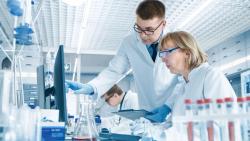
OR WAIT null SECS
- About Us
- Advertise
- Editorial Information
- Contact Us
- Do Not Sell My Personal Information
- Privacy Policy
- Terms and Conditions
© 2024 MJH Life Sciences™ and BioPharm International. All rights reserved.
Development and Commercialization of Biosimilars in India
The author explains the current status of India, the challenges, and recommendations that may alleviate these challenges.
Biosimilars can be defined as biotech drugs that have been shown to have comparable quality, safety, and efficacy to the original product. Scientific and regulatory issues around approval of biosimilars have been a topic of great interest and debate lately in Europe and in the United States. A key concren is industry's limited understanding of how the different quality attributes (QA) of a biotech product affect its safety and efficacy. India is globally regarded to have great potential to become a significant player in the development and commercialization of biosimilars. This article, the 25th in the "Elements of Biopharmaceutical Production" series, aims to present the current status of India in this context, the challenges that need to be overcome, and some recommendations that may alleviate these challenges.
Anurag S. Rathore
GLOBAL SALES PROJECTION FOR BIOSIMILARS
Patents of many top-selling biopharmaceuticals are set to expire (see Figure 1) (1). Expiries will begin in 2012 with the Enbrel (Amgen/Pfizer) patent and continue through 2017. The peak will occur in 2015 when four products—Neulasta (Amgen), Herceptin (Roche), Lantus (Sanofi-Aventis), and Rituxan/MabThera (Roche)—face patent expiration. Sales of biosimilars will be primarily driven by sales in the developed countries (i.e., US and Europe) with the US constituting approximately 90% of the global market.
Elements of Biopharmaceutical Production
A regulatory pathway for approving bisimilars is already in place in Europe—14 such products have been approved to date (1). The pathway in the US, although approved under the Biologics Price Competition and Innovation Act of 2009, is still being implemented. In Japan, although a regulatory guidance for biosimilar approval was issued in 2009, the slow adoption of small-molecule generic drugs suggests that the approval of biosimilars is likely to begin later than in the US.
Figure 1: Upcoming patent expirations of 10 top-selling biopharmaceutical products (Data, Ref. 1). (ALL FIGURES ARE COURTESY OF THE AUTHOR)
THE ECONOMICS OF BIOSIMILARS
Although the financial drivers for growth of biosimilars are widely recognized to be significant, there are some key aspects that distinguish biosimilars from the small-molecule generic drug market. Performance of biosimilars in Germany, the largest biosimilar market at present, shows that the substitution rate for biosimilar epoteins is about 35% of the total sales of epoetin. This percentage is quite different from the >90% rates that are commonly achieved for small-molecule generics (2). This difference is partly due to the observation that patients taking biotech therapeutics show an aversion towards switching to the corresponding biosimilars (3).
PHOTO CREDIT: MARTIN CHILD, GETTY IMAGES
Development and commercialization of a biosimilar requires anywhere from $10–40 million compared with the $1–2 million typicaly required for a conventional small-molecule generic drug. Furthermore, biosimilars are expected to be priced at only a 20–25% discount in comparison with their original products, a significantly smaller discount than what is common with small-molecule generic drugs.
Overall, the effect on overall drug pricing will be much more limited with biosimilars than with small-molecule generics. Patient behavior is also likely to result in slower adoption.
MANUFACTURERS AND CLINICAL RESEARCH ORGANIZATIONS
More than 30 biopharmaceutical companies and clinical research organizations are based in India (see sidebars on companies and contract organizations) (4, 5). The biopharmaceutial sector's estimated value was $1.9 billion in 2009–2010, and accounted for three-fifths of the approximately $3-billion in revenues of the biotech industry in India as a whole. More optimistic projections for sales revenues of biosimilars entering the US and Europe have been estimated as high as $21 billion for the next six to seven years. India is also emerging as a hub for conducting global clinical trials with its share going from 2% at present to 5% by 2012, based on low cost, large and diversified patient pools, easy recruitment, strong government support, availability of specialized doctors and trained investigators, and a gradual strengthening of the IP environment (5, 6).
The clinical research organization market has increased from $5 million in 2005 to $71 million in 2006, and reached $1 billion in 2010 with 50,000 clinical research professionals and 400 clinical trials involving 100,000 patients at 300 sites (7).
Indian companies have gradually advanced from making simpler biotech products, such as the granulocyte colony stimulating factor to manufacturing more complex biotech products, such as monoclonal antibodies (see Table I) (8). Dr. Reddy's has brought biosimilar version of Roche's Rituximab to market.
Table I: Major biosimilars being manufactured in India and their manufacturers (Data, Ref. 8).
Overall, Indian companies have demonstrated that there is no dearth of technical competence as far as development and manufacturing of biotech products is concerned.
COMPETITION AND GLOBAL EXPECTATIONS
A recent survey focused on countries that US firms are considering for outsourcing (see Figure 2). Results showed that Singapore, Ireland and India are the top choices, followed closely by China and Germany. The competition for leadership in development and commercialization will be intense among the more established players (i.e., Germany, Singapore, and Ireland) as well as the emerging ones (i.e., India and China).
Figure 2: Countries that US firms are considering as potential outsourcing destinations. (Data, Ref. 9).
The developed countries (i.e., US, Europe, Japan) have a long history of manufacturing biotech products for regulated markets, but the developing countries have the key advantage of an availabile, qualified, and relatively low-priced workforce. However, more is needed for the latter group to completely embrace the principles and expectations with respect to product quality and GMP compliance, and this will be a large obstacle on the path to these manufacturers emerging as major global players.
The complexity of the biosimilars market is further amplified by industry's inability to completely characterize biotech products through analytical means. As a result, there is limited understanding of how the biotech process affects the quality of the final product and how quality attributes affect clinical safety and efficacy of the product (10, 11).
In the current environment, any missteps by an Indian manufacturer may to result in a perception that the biosimilars manufactured in India (or any other developing country) are not of adequate quality. For example, the Swiss generic-drug maker, Acino, announced that it incurred a loss after European Union authorities required a recall of batches of its drug Clopidogrel, which had been formulated using an active ingredient from an Indian supplier (12). The European regulators ordered the recall after an inspection of the Indian firm led to the finding that it had compromised production records for Clopidogrel.
MOVING FORWARD
Much needs to be done for Indian manufacturers to graduate from being considered "manufacturers for the developing world" to the "manufacturers for the developed and the developing world."
Significant improvements have been made to the country's regulatory system. A systematic, science- and risk-based approach for review of regulatory filings and inspections has been put in place. However, there is a need to ensure greater transparency in the decision-making process so that the outcomes can be more consistent. The current system involves multiple organizations (e.g., the Department of Biotechnology, Central Drugs Standard Control Organization) and ministries of the government. A single point of decision-making and accountability will make the system more efficient, credible, and better coordinated, and will reduce confusion and delays that are otherwise suffered at times by the industry. In addition, basic training in areas such as GMP, documentation practices, scale up, technology transfer, and validation is needed by the industry and regulators.
Creation of modern technology platforms that can support the regulatory authorities in making appropriate decisions during the review and inspection process is needed. For example, approaches such as rapid analysis of a drug lot, fingerprinting, and use of chemometrics to quickly facilitate decision-making on product quality are already in practice by some of the major global regulatory agencies, and India could benefit from these technologies.
The Indian Pharmacopoeia Commission (IPC) is in the process of overhauling its monographs for biotech products. As a creator of the minimum standards that a biotech drug must meet in order to be a commercial product, IPC can play a crucial role in contributing to the success of the Indian biotech industry by using a science-based and risk-based approach when creating these standards.
Professional organizations such as the Parenteral Drug Association (PDA) have been effective in the US in bringing the industry and regulators together in the form of various task forces to create best practices for industry and regulators. International trade organizations, such as the American Chemical Society (ACS) and International Society for Pharmaceutical Engineering (ISPE), also have been effective in the US by encouraging dialogue between academia and industry through conferences and other events.
India could benefit from similar academic–industry collaborations. The Small Business Innovation Research Initiative (SBIRI) from the Department of Biotechnology (DBT) is one step in this direction.
Quality by design (QbD) has gained significant momentum lately in the biotech industry with both regulators and the industry investing financial and staffing resources to implement the approach (13, 14). A QbD approach is likely to be expected of Indian manufacturers when they apply for FDA or EMA approval of biosimilars. The Indian biotech industry should see this as an opportunity to innovate and come up with more efficient ways of product development and commercialization without compromising product quality and consistency.
CONCLUSION
In summary, significant challenges lie ahead for the Indian biotech industry. The government, industry, academia, and regulators need to work together to surmount them. The business case for doing so exists as demonistrated herein. It remains to be seen whether India will capitalize on its strengths and emerge as a dominant global manufacturer of biosimilars.
Anurag S. Rathore* is a member of the faculty of the Department of Chemical Engineering at the Indian Institute of Technology, asrathore@biotechcmz.com
REFERENCES
1. G. Walsh, Nature Biotechnol. 28 (9) 917–924 (2010).
2. J. Hodgson, Nature Biotechnol. 27 (11) 963–965 (2009).
3. P. Narang, Datamonior Biosimilar Series 2008 (Datamonitor, London. June 2009).
4. C. Chakraborty and G. Agoramoorthy, Biotechnology Advances 28 (1) 1–6 (2010).
5. S. Chaturvedi, The Indian Jrnl. of Labour Econ. 52 (2) 693–712 (2009).
6. S. Natesh and M. Bhan, Current Sci. 97, 157–169 (2009).
7. C.J. Mathew, Business Standard (Oct. 2007), p. 16.
8. K. Jayaraman, Nature Biotechnol. 28 (9) 883–884 (2010).
9. E.S. Langer, Gen. Engin. & Biotechnol. News 30 (5) 2010
10. A.S. Rathore, Trends in Biotechnol, 27, (12) 698–705 (2009).
11. A.S. Rathore and I.S. Krull, LCGC North America 28, 598–600 (2010).
12. J.F. Tremblay, Chemical & Engin. News (Aug. 2010), p. 23.
13. A. S. Rathore and H. Winkle H, Nature Biotechnol. 27 (1) (2009) 26–34 (2009).
14. A.S. Rathore, Trends in Biotechnology, 27 (9), 546–553 (2009).



